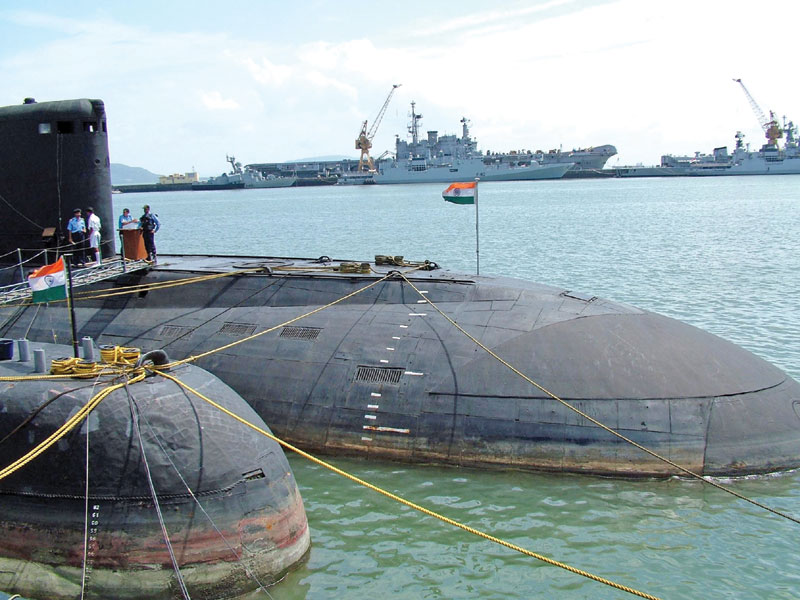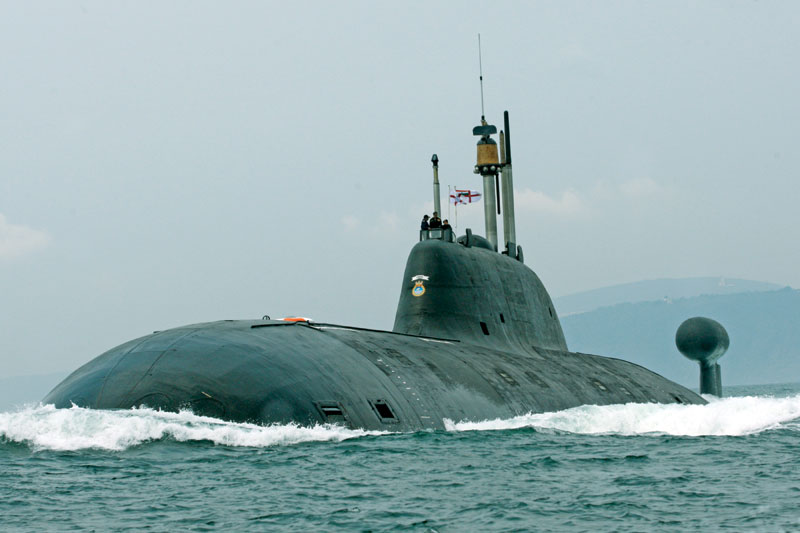The 30-year submarine building plan remains a pipedream
 Capt. Jawahar Bhagwat PhD (retd)
Capt. Jawahar Bhagwat PhD (retd)
Our objective in the ‘Project for Series Construction of Submarines for the Indian Navy and Acquisition of National Competence in Submarine Building’ or the ’30-year submarine building plan’ was to beat the control regimes, identify commercial technologies from wherever suitable, utilise the considerable engineering resources of the country to augment its system integration and software teams alongside the navy’s software groups, pay for process technologies, import these where absolutely necessary; and once and for all put everything together to become a genuine submarine building nation’
— Admiral Vishnu Bhagwat, former Chief of Naval Staff
Presently the Indian Navy is operating the Kilo class (Sindhughosh) submarines, the Type 209 (Shishumar) class and the Scorpene class submarines in the conventional domain. In addition, it operates the nuclear ballistic missile submarine INS Arihant (SSBN) and the nuclear attack submarine INS Chakra (SSN) on lease from Russia.
On 29 December 2019, the Press Trust of India (PTI) reported that a parliamentary panel was informed that in order to strengthen its underwater fleet, the Indian Navy plans to build 24 submarines, including six nuclear attack submarines (SSNs). The navy also informed the panel that Medium Refit Life Certification (MRLC) of the Kilo class submarine INS Sindhuraj has been held up since the Russian side has not been able to submit bank guarantees and integrity pact due to sanctions imposed by the United States (US).
In its report to the parliamentary panel tabled in December 2019, the navy stated that ‘there are presently 15 conventional submarines and two nuclear submarines in its fleet. The Indian Navy has two nuclear submarines INS Arihant and INS Chakra’, leased from Russia. The report highlighted that the ‘majority of the conventional submarines are over 25 years old. Thirteen submarines are between 17 and 32 years’. More than two decades earlier on 24 March 1998, the then CNS Admiral Vishnu Bhagwat raised the issue in the first meeting with the defence minister of the newly-formed Bharatiya Janata Party (BJP) government of ‘a pending proposal of the navy which sought a ‘Statement of Intent’ for a 30-year submarine building plan’ from the Cabinet Committee on Security (CCS). In the book, Betrayal of the Defence Force, Admiral Bhagwat wrote that, ‘The ministry is supposed to have an institutional memory. However, while the previous prime minister, defence minister, finance and home ministers have endorsed the idea and concurred with it in principle, the ministry of defence (MoD) was unable to grasp why we needed such a statement of policy approval. It implied a financial commitment in principle that would be carried from one five-year plan to another.’ (Chapter, 30 Years Submarine Building Plan).
The Admiral invited the attention of the government to the gravity of the decreasing submarine force level observing that ‘Now we had an approved force level of 24 submarines. We had reached the figure of 19 submarines at a point of time. After that, in the last four years (1994-98) we had begun to decommission the first batch of our submarines and block obsolescence was staring in the navy’s face. By the year 2010, we would have an unacceptably low figure for frontline deployment. The import of two submarines (contracts for INS Sindhuraksak commissioned in 1998 and the first missile capable submarine INS Sindhushastra commissioned in 2000 were signed in 1997) and completely knocked down/ semi-knocked down assembly of two or more boats was not how we could plan a submarine force for a maritime nation astride the Indian Ocean. This approach could never lead us to becoming a genuine submarine building nation.’
30-Year Submarine Building Plan
The ‘Project for Series Construction of Submarines for the Indian Navy and Acquisition of National Competence in Submarine Building’ involved building 24 submarines in India over a 30-year time period up to 2030. It was envisaged that 12 submarines would be built with Russian help and 12 with Western assistance. This would avoid over dependence on any one supplier. It was also intended to develop one more shipyard in India in addition to Mazagon Docks Limited (MDL). The rate of building the follow-up submarines was expected to reduce to one every two years once the initial infrastructure had been set up at the shipyards. The 30-year submarine building plan (including both the P75 and P75I programmes) was cleared by the CCS at the height of the Kargil crisis in June 1999.
Underwater technologies are a powerful stimulus as remotely operated vessels/ vehicles and associated robotics, valves, piping, hydraulics, pneumatics, etc. all operated via work stations and software programmes are already the norm. Progress and quality standards in submarine technologies have a mutual synergy with civil underwater technologies. It was important to understand the long-term submarine building plan in this perspective.

Building at home gives a direct investment boost to our shipyards (working at less than 50 per cent capacity utilisation in 1997-98) and also our ancillary industries. Submarine building orders provide a stimulus to our engineers, designers and R&D teams. It gives jobs to our own workers and encourages the development of a highly skilled workforce. Finally, and more importantly, they bring higher quality standards to industry and help the process of competitiveness with the world industry.
Advanced countries have until the recent past, known to have developed several technologies for use on land from their experience on marine platforms. Submarine building galvanises industry to incorporate technologies, industrial processes, skills and last but not the least retention of highly skilled manpower. To assist shipyards and firms like Larsen and Toubro or Tata Consultancy Services in resource planning over a long time period necessitates firm long-term submarine building/ refit/ system orders and in principle commitments to synergise industry’s interests with core national security interests.
Too often the MoD and the navy have backed out from commitments given to reputed companies citing changing defence procurement procedures. This may be contrasted with the example of the US where despite the huge order for SSBNs and SSNs only a limited number of shipyards, both government (Portsmouth Naval Shipyard, Kittery, Maine and Mare island, California) and privately owned (Newport News, Virginia shipyard and Electric Boat Co., Groton, Connecticut which also built the first nuclear submarine) were involved in the construction and refit of nuclear powered submarines. This was also followed by the US government for the supply of important submarine systems, search and rescue equipment and batteries despite US congressional oversight which also fully understood the requirements of the nuclear submarine programme.
In India, procurement of mission critical equipment such as submarine batteries has been delayed frequently resulting in operational limitations/ safety issues due to ongoing litigation based on an incomplete understanding of the way that a submarine operates. Finally, in January 2016 after protracted litigation the Supreme Court passed a judgement in which it remarked, ‘The only source of power to a submarine when it dives beyond nine metres into sea/ ocean is submarine batteries. Batteries are the unique source of electric energy in underwater navigation… If the batteries fail, the submarine will be without power and it can have catastrophic consequences on men as also submarine would be lost’.
However, this incomplete understanding of submarine issues particularly by members of the defence accounts department is not surprising as this author has personally experienced the reluctance of a joint secretary (Navy), certain members of the Parliamentary standing committee on defence and integrated financial advisors to visit a submarine when berthed alongside or in dry-dock citing absurd reasons of ‘it’s too dangerous or there is danger of radiation and other harmful gases.’ Unfortunately, these are some of the power centres that either influence or take decisions affecting the man at sea who is on the frontline, directly in harm’s way, facing adverse conditions.
Force Level of Submarines
In a significant development, India reportedly handed over a Kilo class submarine INS Sindhuvir to Myanmar in December 2019 adding to the crowded underwater space in the Bay of Bengal.
INS Sindhuvir was refitted and modernised by the Hindustan Shipyard Limited (HSL). It is not known whether Russian approval has been taken for this transfer. This transfer is possibly a counterpoint to acquisition by Bangladesh of two Chinese submarines. Thailand has also scheduled to acquire three Chinese submarines.
Despite their age, the Kilo class submarines continue to be hard to detect and this would complicate safety of our own submarines in the Bay of Bengal unless we have put down certain operating restrictions in the transfer agreement. However, in the considered opinion of this author the proliferation of submarines in the Bay of Bengal is a failure of our foreign policy towards our South Asian/ South East Asian neighbours and our much-touted claim of being a net security provider in the Indian Ocean Region (IOR).
The IOR, the area of operations of the Indian Navy, has witnessed rising activities of the Chinese Navy including regular forward deployments by its submarines in the IOR. On its part, the Indian Navy has been revamping its infrastructure, including procuring new ships. However, the period 2001–2019, witnessed the commissioning of only three submarines: INS Chakra in 2012, INS Kalvari in 2017 and INS Khanderi in 2019.
Due to the delay in submarine construction projects, including the six Project 75 submarines at Mazagaon Docks, Mumbai, the defence ministry has approved Medium Refit cum Life Certification or MRLC of six older submarines, so that the force levels do not decline drastically. However, the navy’s report did not elaborate on the status of the Project 75I submarine building plan and the reasons for the tardy progress on the 30 year submarine building plan, despite an already approved force level of 24 submarines.
Successive defence ministers, defence secretaries (responsible for the defence of the country as per the government rules of business, 1961) and most chiefs of the naval staff, from 1999 are chiefly responsible for this sorry state of affairs which has resulted in reducing force levels and consequent low operational availability of submarines, exacerbated by widespread cannibalisation of spare parts from one submarine to the other to keep the operational submarines combat worthy, sometimes for extended periods.
The approvals for these transfers are beyond the purview of the Commodore Commanding Submarines (East or West) and frequently also beyond the authority of the Flag Officers Commanders-in-Chief (or Submarine Operating Authorities) in Mumbai and Visakhapatnam and need the approval of the Integrated Headquarters Ministry of Defence (Navy) [IHQ, MoD (Navy)]. However, late reporting of these cannibalisation transfers to IHQ, MoD (Navy) results in delayed procurement action and non-availability to the submarines which are scheduled to complete their maintenance refits, thus creating a vicious cycle.

Medium Refit cum Life Certification
The defence ministry cleared a long overdue Rs 4,800 crore proposal for refits of six submarines in October 2015. These would involve refitting two submarines each at Zvezdockhka, Severodvinsk; Mazagaon Dock Ltd, Mumbai; and Naval Dockyard, Mumbai. Refits have been scheduled at Naval Dockyard, Mumbai despite the well-known unacceptable time delays in the medium refit-cum-modernisation of INS Shishumar which took over five years to complete. It is not known whether these refits would also include replacement of the diesel engines and the associated systems which are a major cause for poor availability of the Sindhughosh class submarines due to lack of spares.
The Russian side had offered to replace the diesel engines and the associated systems for earlier refits but as usual an accountant’s view prevailed. The main reason for delay in refits in Naval Dockyards is that they are more focused on the maintenance requirements of operational ships/ submarines and short refitting periods. Procurement of spares is often delayed and project teams while constituted have frequent changes in personnel thus affecting the refit.
The navy submission to the Parliamentary panel said, “Contract conclusion for Medium Refit cum Life Certification (MRLC) of second submarine, Sindhuraj, is held up since the Russian side has not been able to submit requisite bank guarantees and integrity pact as a result of the sanctions imposed by the US government on them.”
The US has imposed sanctions on Moscow citing several reasons ranging from the alleged annexation of Crimea region of Ukraine to Russia with the recent one being the Countering America’s Adversaries through Sanctions Act (CAATSA). According to a PTI report, the navy has also recommended to the defence ministry that corporate guarantee of the JSC United Shipbuilding Corporation, a 100 per cent Russian government-owned firm could be accepted and fast-track approval of the competent authority accorded for contract conclusion. How long this would take is anyone’s guess or will it be another case when strategic autonomy is only on paper. Meanwhile, INS Sindhuraj has not been operational since 2016.
As stated earlier, the defence ministry had originally cleared this contract in October 2015. It also took an inordinately long time to clear the maintenance support contract of INS Chakra post commissioning which resulted in poor operational availability of the platform in 2012-13. This despite the fact that the submarine’s commissioning itself was delayed and there was more than sufficient time to work out the modalities of the contract.
The navy’s report to the panel observed that, “The Russian side has indicated that M/s L&T as their preferred partner for undertaking MRLC of the third submarine Sindhuratna in India.” However, will this pass muster with the procurement procedures of the defence ministry in the background of the Supreme Court judgement and will it be costly for the navy in terms of the actual time taken to refit these submarines, remains to be seen.
The Defence PSU HSL took nine years for the refit of INS Sindhukirti (Kilo class submarines) and the quality of work had a deleterious impact on the operational availability of this submarines post refit whereas Zvezdochka took 2.5 years for a similar refit. A detailed analysis of the operational availability of a submarine post a Russian refit vis-a-vis an Indian refit would reveal an adverse contrast in terms of operational availability of the platforms and the ability to be sent for forward deployment.
This was commented by the Comptroller and Auditor General (CAG) in its performance audit of the submarine arm submitted to the government in 2008: “Other than holding 67 per cent of the submarines envisaged by the Maritime Perspective Plan, 1985, the Indian Navy faces the prospect of having to operate with less than half of its current submarine fleet by 2012, when 63 per cent (two-thirds) of the Indian Navy’s submarines will be due for retirement.”
It also stated that only 48 per cent of the submarine’s fleet was operational between January 2002 and December 2006 as a result of prolonged refit schedules. According to CAG, 83 per cent of short submarine refits and 100 per cent of normal and medium refits fell behind schedule. It recommended that, “The MoD should take all possible measures to expedite the acquisition and construction of submarines in accordance with its 30-year submarine construction plan and maximise combat readiness by maintaining operating standards and refitting submarines on time.”
There have been reports in the Indian media that Russia delayed refit to weaken HSL, but the fact remains that even more than three decades post the commissioning of INS Sindhughosh, we are still dependent upon the Russian side for certification of the hull structures and other important systems of a Kilo class submarine though many technical officers have been deputed as part of submarine overseeing teams in Russia.
In addition, the navy has trained many naval architects in Russia. The Naval Dockyard/ HSL is also unable to replicate the work procedures and quality control of the Russian ship repair yard in India due to lack of will and inability to lay down strict work procedures and productivity standards due to union issues which are tacitly supported by the political leadership. CAG severely chastised the HSL and also the navy for the delays in the refit which took nine years (2006-2015) to complete.
However, what needs to be also kept in mind is that the submarine was not deployed since June 2004 due to maintenance issues since it was due to commence the Medium Refit in 2001. In effect, consequently the time it was non-available to the navy was even greater. In its recommendations, CAG report recommended that “the planning and commencement of refit of submarines should be as per schedule to avoid excessive exploitation of vessels extension of refitting time. The ministry should ensure that efforts are augmented to improve the scale of utilisation of indigenous materials in line with its own directives. The navy should establish a dedicated Project Team, the expertise of which is available to each indigenous offloaded refit.”
It is not known whether the parliamentary panel on defence asks for an action taken report by the government/ MoD/ navy on the recommendations of CAG since no mention was found by this author in any of the annual reports of the parliamentary panel on defence. It is suggested that this may be considered by the panel for future reports to ensure that lessons learnt are not repeated.
(The writer is a former Captain of INS Chakra, INS Shishumar and INS Shalki. He also served on the Sindhughosh [Kilo] class submarines)
The concluding part of the article will appear in the April issue of FORCE.

